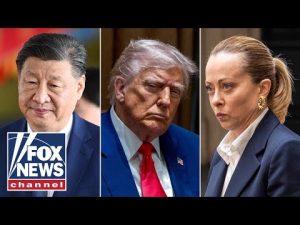This morning, the financial world was buzzing with optimism as the Dow Jones Industrial Average made a stunning recovery after some challenging days. Investors were glued to their screens as the Dow jumped by nearly 1,500 points at one point, painting a pretty picture in green as markets opened. The big conversation of the day? President Trump’s controversial tariffs and the potential for swift deals with trade partners. It seems that some investors are feeling hopeful that the administration’s aggressive approach will lead to meaningful negotiations and agreements.
Word from the Treasury Secretary, Scott Bessent, added some fuel to that fire. He revealed that over 70 countries have reached out to the White House, eager to kickstart negotiations and “cut a deal.” That’s a lot of interest, considering the current backdrop of tariff debates and trade tensions. As markets opened, the enthusiasm was palpable, and it seemed like everyone was holding their breath to see if this wave of positivity would last.
However, just as the thrill of the early gains started to settle in, the excitement began to fade. By the end of the trading day, the Dow concluded in a sea of red as investors took a cautious step back. They faced a harsh reality: China had missed its deadline to roll back a staggering 34% counter-tariff, and now, in a matter of hours, the stakes would rise even higher with imports bearing a whopping 104% tariff. It’s like watching a high-stakes poker game, where China is certainly feeling the pressure as its economy’s vulnerabilities become more evident.
China’s economic woes have been substantial, with local governments drowning in debt and its property market reportedly in shambles. Consumer confidence is taking a dive, and external demand—the U.S. market—has become a crucial, but shaky, support system. With all the drama surrounding tariffs, the reality check is that the playing field might be more tilted than it first appears. While Democrats fret over slight fluctuations in the Dow, China’s economy is in a precarious state, struggling to maintain balance. If there’s ever a time for the U.S. to assert itself in trade negotiations, it’s now.
President Trump’s timing for tackling these trade issues seems strategically sound. He claims the tariffs are reeling in nearly $2 billion each day, making it clear that this is about more than just political grandstanding. The President touted the idea of “tailored deals,” suggesting that Japan, South Korea, and possibly others are looking to create custom agreements that could bolster the U.S. economy. If this strategy delivers results, it could mean job creation and an economic uptick that would benefit American workers.
Moreover, discussions of hiring surges and better-paying jobs are hitting the airwaves, painting a hopeful picture of a future where factories are buzzing and the American worker is thriving again. This renewed focus on middle-class jobs, which have often taken a back seat in political conversations, marks a significant shift in priorities. It seems that for the first time in ages, the needs of the working class are being brought to the forefront, even if it takes some bold moves from the government to get there.
While this renewed focus on the working class seems promising, the Democratic Party appears less interested, instead focusing their efforts on critiquing the administration without proffering any substantial alternatives. As they scramble through the remnants of previous strategies, many wonder whether they can regain their footing amid the roaring political winds. The days ahead will reveal if these trade negotiations yield the desired outcomes or if the market will return to its erratic behavior, leaving everyone second-guessing once again. Only time will tell if the American economy is on the brink of a prosperous new chapter or if additional bumps await down the road.







